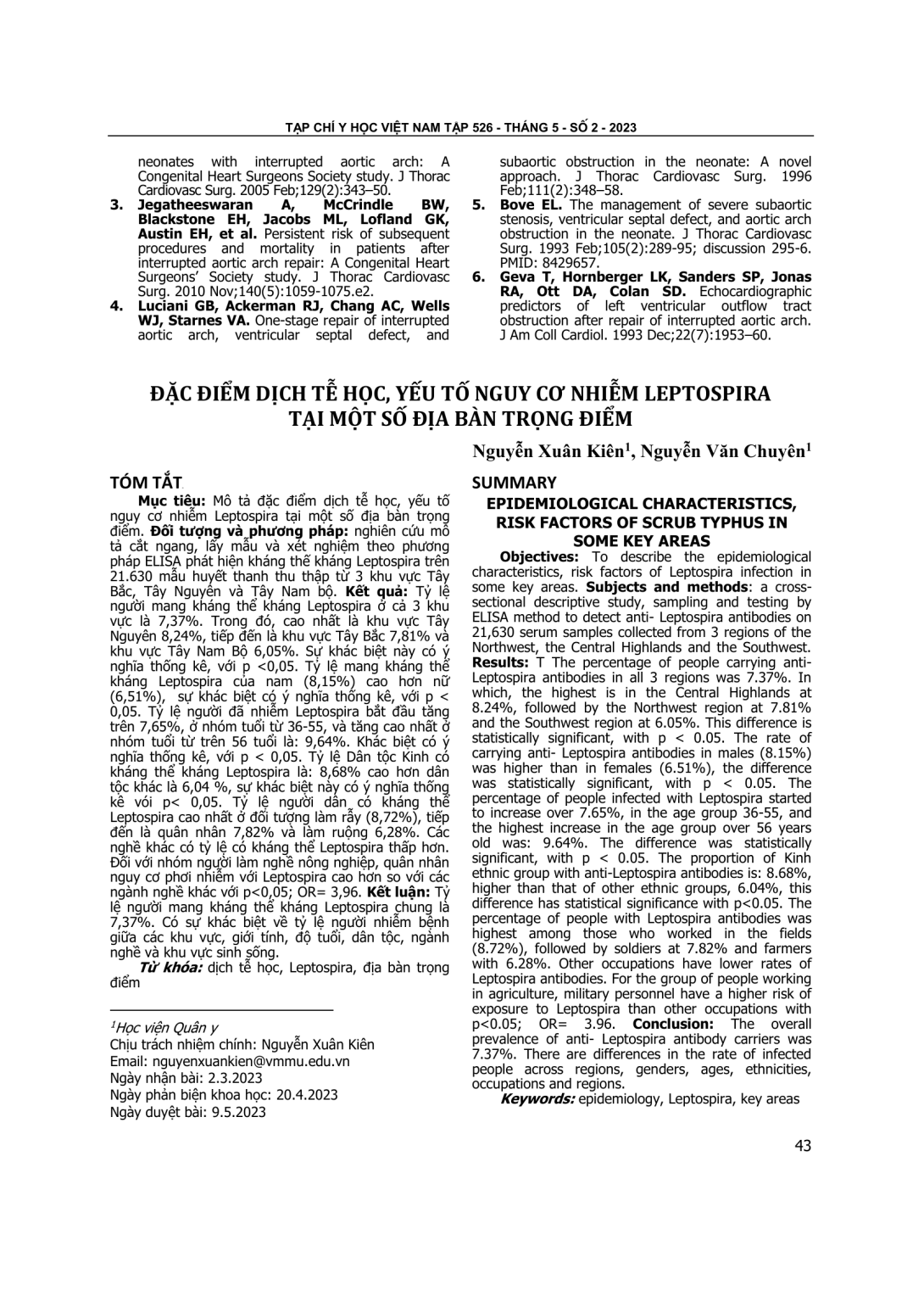
Mô tả đặc điểm dịch tễ học, yếu tố nguy cơ nhiễm Leptospira tại một số địa bàn trọng điểm. Đối tượng và phương pháp: nghiên cứu mô tả cắt ngang, lấy mẫu và xét nghiệm theo phương pháp ELISA phát hiện kháng thế kháng Leptospira trên 21.630 mẫu huyết thanh thu thập từ 3 khu vực Tây Bắc, Tây Nguyên và Tây Nam bộ. Kết quả: Tỷ lệ người mang kháng thể kháng Leptospira ở cả 3 khu vực là 7,37%. Trong đó, cao nhất là khu vực Tây Nguyên 8,24%, tiếp đến là khu vực Tây Bắc 7,81% và khu vực Tây Nam Bộ 6,05%. Sự khác biệt này có ý nghĩa thống kê, với p <0,05. Tỷ lệ mang kháng thể kháng Leptospira của nam (8,15%) cao hơn nữ (6,51%), sự khác biệt có ý nghĩa thống kê, với p < 0,05. Tỷ lệ người đã nhiễm Leptospira bắt đầu tăng trên 7,65%, ở nhóm tuổi từ 36-55, và tăng cao nhất ở nhóm tuổi từ trên 56 tuổi là: 9,64%. Khác biệt có ý nghĩa thống kê, với p < 0,05. Tỷ lệ Dân tộc Kinh có kháng thể kháng Leptospira là: 8,68% cao hơn dân tộc khác là 6,04 %, sự khác biệt này có ý nghĩa thống kê vói p< 0,05. Tỷ lệ người dân có kháng thể Leptospira cao nhất ở đối tượng làm rẫy (8,72%), tiếp đến là quân nhân 7,82% và làm ruộng 6,28%. Các nghề khác có tỷ lệ có kháng thể Leptospira thấp hơn. Đối với nhóm người làm nghề nông nghiệp, quân nhân nguy cơ phơi nhiễm với Leptospira cao hơn so với các ngành nghề khác với p<0,05; OR= 3,96. Kết luận: Tỷ lệ người mang kháng thể kháng Leptospira chung là 7,37%. Có sự khác biệt về tỷ lệ người nhiễm bệnh giữa các khu vực, giới tính, độ tuổi, dân tộc, ngành nghề và khu vực sinh sống.
To describe the epidemiological characteristics, risk factors of Leptospira infection in some key areas. Subjects and methods: a cross-sectional descriptive study, sampling and testing by ELISA method to detect anti- Leptospira antibodies on 21,630 serum samples collected from 3 regions of the Northwest, the Central Highlands and the Southwest. Results: T The percentage of people carrying anti- Leptospira antibodies in all 3 regions was 7.37%. In which, the highest is in the Central Highlands at 8.24%, followed by the Northwest region at 7.81% and the Southwest region at 6.05%. This difference is statistically significant, with p < 0.05. The rate of carrying anti- Leptospira antibodies in males (8.15%) was higher than in females (6.51%), the difference was statistically significant, with p < 0.05. The percentage of people infected with Leptospira started to increase over 7.65%, in the age group 36-55, and the highest increase in the age group over 56 years old was: 9.64%. The difference was statistically significant, with p < 0.05. The proportion of Kinh ethnic group with anti-Leptospira antibodies is: 8.68%, higher than that of other ethnic groups, 6.04%, this difference has statistical significance with p<0.05. The percentage of people with Leptospira antibodies was highest among those who worked in the fields (8.72%), followed by soldiers at 7.82% and farmers with 6.28%. Other occupations have lower rates of Leptospira antibodies. For the group of people working in agriculture, military personnel have a higher risk of exposure to Leptospira than other occupations with p<0.05; OR= 3.96. Conclusion: The overall prevalence of anti- Leptospira antibody carriers was 7.37%. There are differences in the rate of infected people across regions, genders, ages, ethnicities, occupations and regions.
- Đăng nhập để gửi ý kiến
